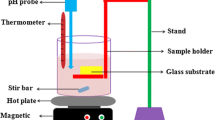Abstract
The thermochemical treatment of tungsten trioxide (WO3) nanostructured films in hydrogen sulfide to obtain tungsten disulfide (WS2) layers in the WS2/WO3 hybrid structure is studied. The temperature and treatment time influence the structural-phase state, morphology, optical properties of a WS2/WO3/FTO photocathode (on fluorinated tin oxide (FTO) substrates), and its photoelectrocatalytic activity in the hydrogen evolution reaction in acidic solution is established. The sulfidation of WO3 nanoneedle films leads to the formation of a WS2/WO3 nanocrystalline hybrid structure under optimal conditions, which provides the separation of photogenerated carriers (electrons and holes) at the interphase boundaries (heterojunctions) necessary for the efficient photoactivated hydrogen evolution reaction according to Z scheme. The calculations of thermodynamic properties of the WS2/WO3 hybrid nanocatalyst show that synergistic effect of nanophases is possible in it to increase the catalytic activity of hydrogen evolution both on the basal planes of WS2 nanoclusters and on the surface of metal oxide nanoclusters.








Similar content being viewed by others
REFERENCES
Maeda, K. and Teramura, K., Photocatalyst releasing hydrogen from water, Nature, 2006, vol. 440, art. ID 295. https://doi.org/10.1038/440295a
Yang, W., Ramanujam Prabhakar, R., Tan, J., Tilley, S.D., and Moon, J., Strategies for enhancing the photocurrent, photovoltage, and stability of photoelectrodes for photoelectrochemical water splitting, Chem. Soc. Rev., 2019, vol. 48, pp. 4979–5015. https://doi.org/10.1039/c8cs00997j
Huang, Z.-F., Song, J., Pan, L., Zhang, X., Wang, L., and Zou, J.-J., Tungsten oxides for photocatalysis, electrochemistry and phototherapy, Adv. Mater., 2015, vol. 27, pp. 5309–5327. https://doi.org/10.1002/adma.201501217
Zhang, S., Chen, S., Liu, D., Zhang, J., and Peng, T., Layered WS2/WO3 Z-scheme photocatalyst constructed via an in situ sulfurization of hydrous WO3 nanoplates for efficient H2 generation, Appl. Surf. Sci., 2020, vol. 529, art. ID 147013. https://doi.org/10.1016/j.apsusc.2020.147013
Liu, D., Zhang, S., Wang, J.M., Peng, T.Y., and Li, R.J., Direct Z-scheme 2D/2D photocatalyst based on ultrathin g-C3N4 and WO3 nanosheets for efficient visible-light driven H2 generation, ACS Appl. Mater. Interfaces, 2019, vol. 11, pp. 27913–27923. https://doi.org/10.1021/acsami.9b08329
Fominski, V., Romanov, R., Fominski, D., Soloviev, A., Rubinkovskaya, O., Demin, M., Maksimova, K., Shvets, P., and Goikhman, A., Performance and mechanism of photoelectrocatalytic activity of MoSx/WO3 heterostructures obtained by reactive pulsed laser deposition for water splitting, Nanomaterials, 2020, vol. 10, no. 5, art. ID 871. https://doi.org/10.3390/nano10050871
Fominski, V., Grigoriev, S., Romanov, R., Zuev, V., and Grigoriev, V., Properties of tungsten oxide thin films formed by ion–plasma and laser deposition methods for MOSiC-based hydrogen sensors, Semiconductors, 2012, vol. 46, no. 3, pp. 401–409. https://doi.org/10.1134/S1063782612030098
Fominski, V., Gnedovets, A., Fominski, D., Romanov, R., Kartsev, P., Rubinkovskaya, O., and Novikov, S., Pulsed laser deposition of nanostructured MoS3/np-Mo//WO3 – y hybrid catalyst for enhanced (photo) electrochemical hydrogen evolution, Nanomaterials, 2019, vol. 9, no. 10, art. ID 1395. https://doi.org/10.3390/nano9101395
Nevolin, V.N., Grigoriev, S.N., Fominski, V.Yu., Romanov, R.I., Volosova, M.A., Fominski, D.V., and Dzhumaev, P.S., Application of pulsed laser deposition in reactive gaseous media to fabricate an effective hybrid MoSx/WOy catalyst for the reaction of hydrogen evolution, Inorg. Mater.: Appl. Res., 2018, vol. 9, no. 2, pp. 297–304. https://doi.org/10.1134/S2075113318020211
Li, J., Hong, W., Jian, C., Cai, Q., and Liu, W., Seamless tungsten disulfide-tungsten heterojunction with abundant exposed active sites for efficient hydrogen evolution, Appl. Catal., B, 2019, vol. 244, pp. 320–326. https://doi.org/10.1016/j.apcatb.2018.11.042
Chen, S., Xiao, Y., Xie, W., Wang, Y., Hu, Z., Zhang, W., and Zhao, H., Facile strategy for synthesizing nonstoichiometric monoclinic structured tungsten trioxide (WO3 – x) with plasma resonance absorption and enhanced photocatalytic activity, Nanomaterials, 2018, vol. 8, art. ID 553. https://doi.org/10.3390/nano8070553
Kumar, P., Singh, M., Gopal, P., and Reddy, G.B., Sulfurization of WO3 nanorods into WS2 as a function of H2S/Ar partial pressure, AIP Conf. Proc., 2018, vol. 1953, art. ID 030252. https://doi.org/10.1063/1.5032587
Wu, Z., Fang, B., Bonakdarpour, A., Sun, A., Wilkinson, D.P., and Wanga, D., WS2 nanosheets as a highly efficient electrocatalyst for hydrogen evolution reaction, Appl. Catal., B, 2012, vol. 125, pp. 59–66. https://doi.org/10.1016/j.apcatb.2012.05.013
Liu, M., Geng, A., and Yan, J., Construction of WS2 triangular nanoplates array for hydrogen evolution reaction over a wide pH range, Int. J. Hydrogen Energy, 2020, vol. 45, no. 4, pp. 2909–2916. https://doi.org/10.1016/j.ijhydene.2019.11.053
Wang, X., Gan, X., Hu, T., Fujisawa, K., Lei, Y., Lin, Z., Xu, B., Huang, Z., Kang, F., Terrones, M., and Lv, R., Noble-metal-free hybrid membranes for highly efficient hydrogen evolution, Adv. Mater., 2016, vol. 29, art. ID 1603617. https://doi.org/10.1002/adma.201603617
Tsai, Ch., Chan, K., Abild-Pedersen, F., and Nørskov, J.K., Active edge sites in MoSe2 and WSe2 catalysts for the hydrogen evolution reaction: A density functional study, Phys. Chem. Chem. Phys., 2014, vol. 16, art. ID 13156. https://doi.org/10.1039/c4cp01237b
Funding
The studies concerning WS2/WO3/FTO hybrid nanomaterials, their structural and phase characteristics, and experimental and theoretical analysis of photoelectrocatalytic properties were performed at the National Research Nuclear University MEPhI and financially supported by the Russian Ministry of Science and Higher Education (project FSWU-2020-0035). The optical properties of nanomaterials were studied at the Baltic Federal University in Research and Educational Center “Functional Nanomaterials” with the financial support of the Russian Ministry of Science and Higher Education (project FZWM-2020-0008).
Author information
Authors and Affiliations
Corresponding authors
Additional information
Translated by A. Tulyabaev
Rights and permissions
About this article
Cite this article
Nevolin, V.N., Fominski, D.V., Romanov, R.I. et al. Influence of Sulfidation Conditions of WO3 Nanocrystalline Film on Photoelectrocatalytic Activity of WS2/WO3 Hybrid Structure in Production of Hydrogen. Inorg. Mater. Appl. Res. 12, 1139–1147 (2021). https://doi.org/10.1134/S2075113321050270
Received:
Revised:
Accepted:
Published:
Issue Date:
DOI: https://doi.org/10.1134/S2075113321050270




